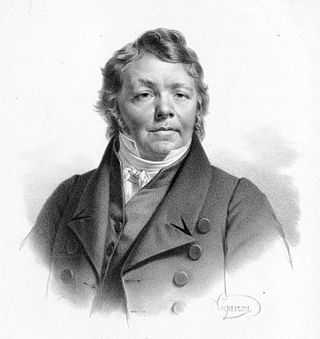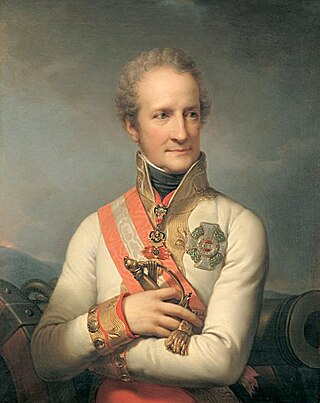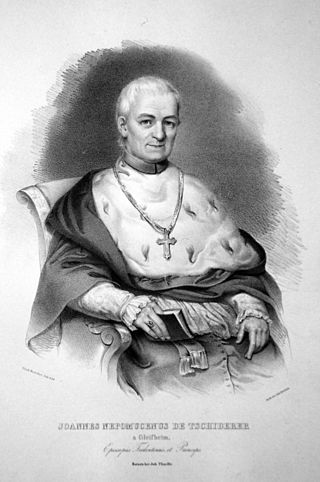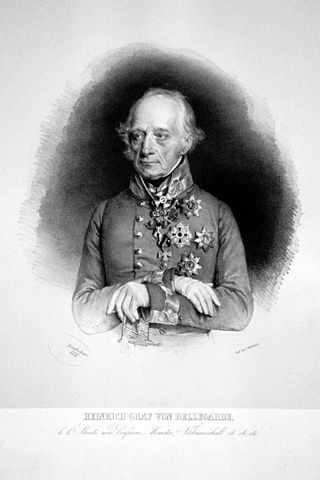Related Research Articles

Johann Nepomuk Hummel was an Austrian composer and virtuoso pianist. His music reflects the transition from the Classical to the Romantic musical era. He was a pupil of Mozart, Salieri and Haydn. He also knew Beethoven and Schubert.

Johann I Joseph was Prince of Liechtenstein between 1805 and 1806 and again from 1814 until 1836. He was the last Liechtenstein prince to rule under the Holy Roman Empire between 1805 and 1806 and as regent of Liechtenstein from 1806 until 1814. He was the fourth son of Franz Joseph I, Prince of Liechtenstein.

Joseph Johann Adam was the Prince of Liechtenstein from 1721 to his death.

Johann Nepomuk Eduard Ambrosius Nestroy was a singer, actor and playwright in the popular Austrian tradition of the Biedermeier period and its immediate aftermath. He participated in the 1848 revolutions and his work reflects the new liberal spirit then spreading throughout Europe.

The House of Harrach is the name of an old and influential Austro-German noble family, which was also part of the Bohemian nobility. The Grafen (Counts) of Harrach were among the most prominent families in the Habsburg Empire. As one of a small number of mediatized families, it belongs to the Uradel.

Johann Nepomuk Fuchs was an Austrian composer, opera conductor, teacher and editor. His editorial work included an important role in the preparation of the first complete edition of Franz Schubert's works. He was an older brother of the composer Robert Fuchs.

Johann Nepomuk von Tschiderer zu Gleifheim was an Austrian-Italian Roman Catholic prelate and the Bishop of Trent from 1834 until his death. He was born to Austrians but was considered to be an Austro-Italian due to having been born in the Italian town of Bolzano.

Ernest Johann Nepomuk, Imperial Count von Herberstein, was the first bishop of the diocese of Linz from 1785 to 1788.

Hans Canon was the pseudonym of Johann Baptist Strašiřipka, an Austrian history and portrait painter.
Kutschera is a Germanized version of Czech surname Kučera. Notable people with the surname include:

Johann Nepomuk Berger was an Austrian lawyer, politician and writer.

General of the Cavalry was a rank in the Imperial Army of the Holy Roman Empire, Imperial Army of the Austrian Empire and the Army of Austria-Hungary.

Johann Nepomuk, Graf von Nostitz-Rieneck commanded a cavalry division in the army of the Austrian Empire during the Napoleonic Wars.

Johann Nepomuk Schaller was an Austrian sculptor. His most famous work is a bust of Ludwig van Beethoven at age 55, created at the request of the composer's secretary Karl Holz in 1825. It was later presented to the Royal Philharmonic Society, London, on the occasion of the Beethoven Centennial.

The Kutschera family is a Bohemian and Austrian noble family descended from Matthäus Kutschera, a burgher of Leitmeritz, who became an accountant for the Prämonstratenserstift Strahow outside Prague.

Johann Nepomuk Hoechle was an Austrian painter and lithographer who specialized in scenes from military actions and current events.

Eduard Gurk was an Austrian landscape painter and printmaker, who worked for the Habsburg Court under the Emperors Francis I and Ferdinand I. He was especially well known as a watercolorist.

Johann Nepomuk Fischer was an Austrian ophthalmologist. He is considered to be the founder of modern ophthalmology in Bohemia.

Johann Maximilian von Lamberg was an Austrian nobleman, diplomat and courtier. In the service of the Habsburgs, he excelled in the peace negotiations at the end of the Thirty Years' War, resulting in the Peace of Westphalia. Later in high offices he was one of the influential figures of the imperial court. In addition to gaining the title of count (1641), he expanded the family property in various parts of the Empire.

Johann Nepomuk Isfordink and from 1835 Isfordink Edler von Kostnitz was an Austrian army physician. He was involved in raising the Josephinian Military Academy of Surgery in Vienna to the status of a university and wrote several books.
References
- ↑ Egger: " Kutschera Johann Nepomuk Frh. von ". In: Österreichisches Biographisches Lexikon 1815–1950 (ÖBL). Vol. 4, Austrian Academy of Sciences , Vienna 1969, p. 375.